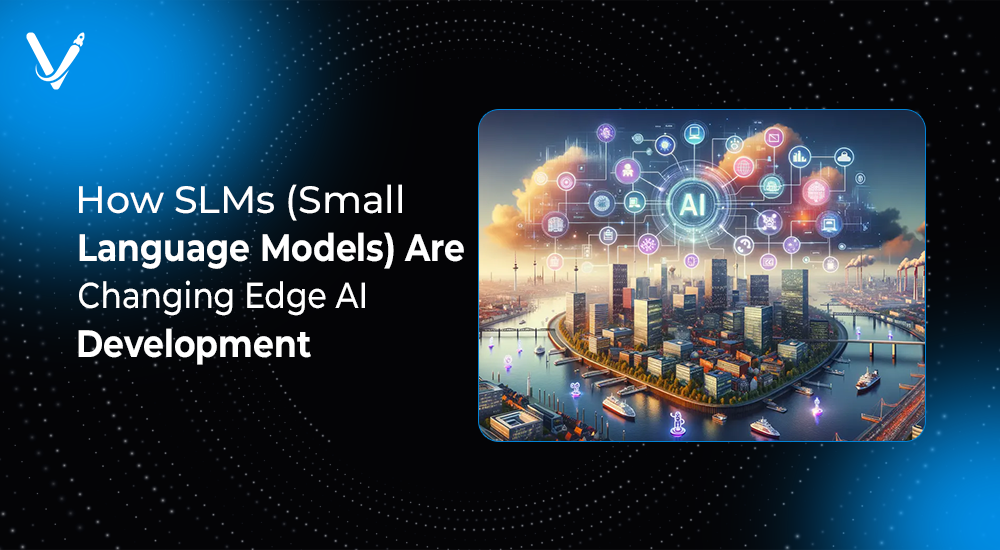How SLMs (Small Language Models) Are Changing Edge AI Development


- Aug 13, 2025



For years, artificial intelligence revolved around the mantra “bigger is better.” Large Language Models (LLMs) like GPT-4, Claude, and Gemini pushed the boundaries of human-computer interaction by processing vast amounts of information and generating remarkably human-like responses. But size comes at a cost—massive computational requirements, cloud dependency, high latency, and ongoing energy demands.
Enter Small Language Models (SLMs)—the leaner, faster siblings of LLMs that pack impressive intelligence into a fraction of the size. These models are tailor-made for Edge AI, where computational work happens on the device rather than relying on distant data centers. Imagine your phone understanding complex commands instantly, a factory sensor detecting anomalies without internet access, or a drone processing voice navigation mid-flight—SLMs make these scenarios possible.
This article unpacks how SLMs are reshaping edge AI development, the technologies powering them, and how industries are already integrating them to deliver better, faster, and more secure AI experiences.
A Small Language Model is essentially a lightweight neural network trained for natural language processing but optimized for efficiency and portability. While LLMs may range from tens to hundreds of billions of parameters, SLMs can function effectively with tens of millions to a few billion parameters.
This smaller footprint allows them to be deployed on smartphones, IoT devices, embedded systems, and edge servers—making AI accessible without expensive infrastructure.
SLMs reflect a growing recognition in AI development: context-specific intelligence often trumps raw size. Not every use case requires the encyclopedic knowledge of an LLM. Sometimes, speed, privacy, and reliability matter more than an exhaustive database of facts.
For instance:
| Feature | LLMs (Large Language Models) | SLMs (Small Language Models) |
| Parameter Count | 10B - 500B+ | 50M - 3B |
| Latency | High (due to network & compute) | Very Low (on-device processing) |
| Hardware Need | High-end GPUs, data center clusters | Mobile CPUs, NPUs, edge accelerators |
| Privacy | Often cloud-dependent | Can operate fully offline |
| Energy Efficiency | High power consumption | Optimized for low power usage |
| Use Cases | Complex, multi-domain reasoning | Task-specific, real-time edge intelligence |
In edge AI applications, every millisecond counts. A self-driving car interpreting a voice command to “turn left now” can’t afford a cloud round-trip delay. SLMs process the request instantly on-device, ensuring real-time responsiveness.
Data doesn’t have to leave the device. This is critical for:
By processing locally, SLMs dramatically reduce data breach risks.
Running AI in the cloud is expensive—not just in hosting costs but also in energy consumption. For companies deploying AI at scale, SLMs mean:
SLMs make advanced AI available in rural or low-connectivity environments—vital for global-scale adoption in agriculture, education, and disaster relief.
Developers employ specialized methods to shrink model size without destroying performance:
SLMs shine when paired with edge AI accelerators:
While full training still requires high compute power, lightweight fine-tuning can be done directly on devices for:
Future SLMs will handle text, audio, and visual data simultaneously, enabling:
Models could learn from data across millions of devices without centralizing data, improving performance while preserving privacy.
Instead of generic assistants, we’ll see domain-focused SLMs for:
Small Language Models are transforming edge AI from a promising concept into a practical, scalable reality. By enabling fast, private, and cost-efficient AI processing directly on devices, they open the door to a new generation of applications in healthcare, manufacturing, automotive, and beyond.
At Vasundhara Infotech, we help businesses design and deploy SLM-powered edge AI solutions that are tailored to industry needs, optimized for performance, and future-ready. If you’re ready to explore the possibilities of on-device intelligence, our AI experts can guide you from concept to deployment.
Copyright © 2026 Vasundhara Infotech. All Rights Reserved.